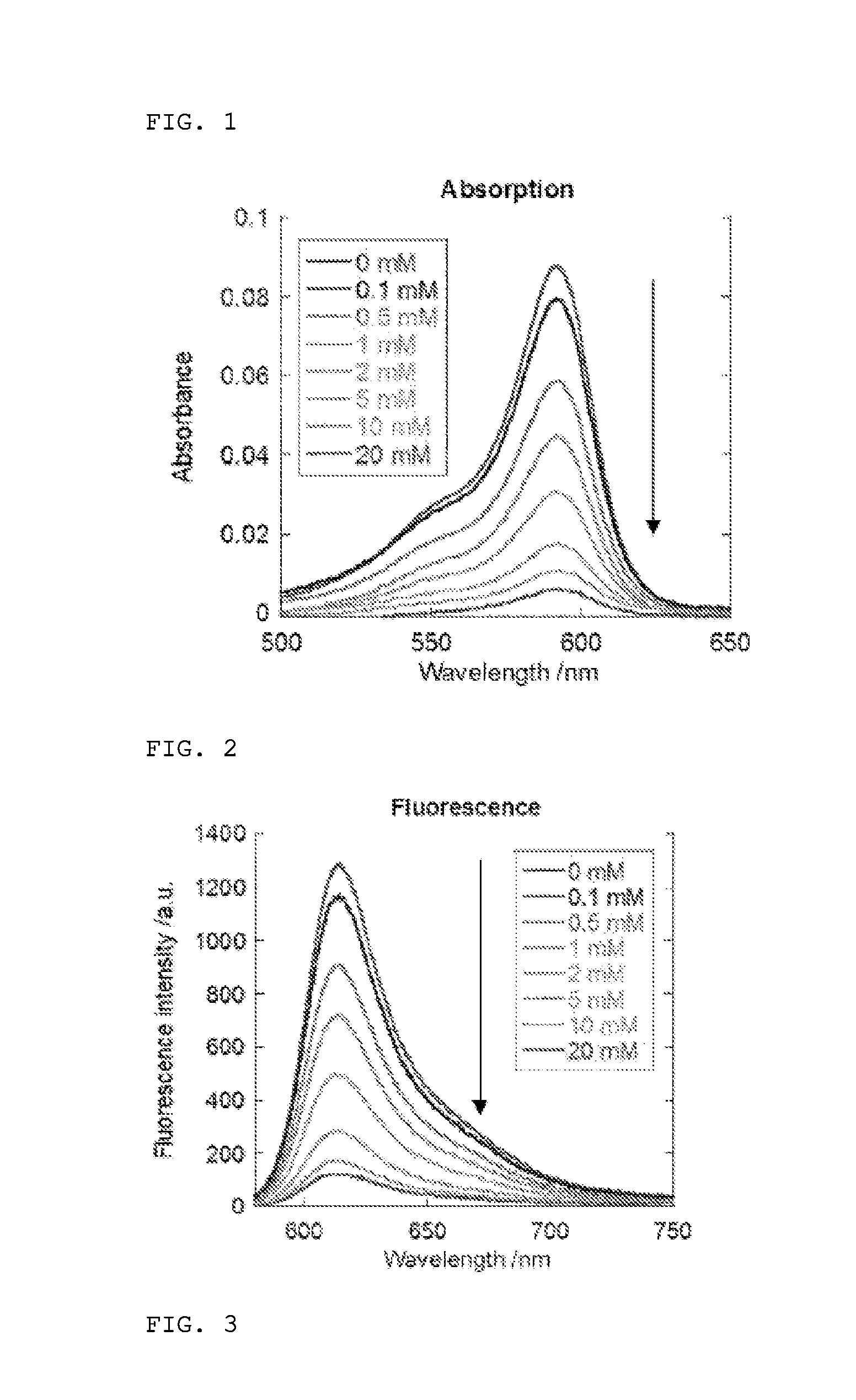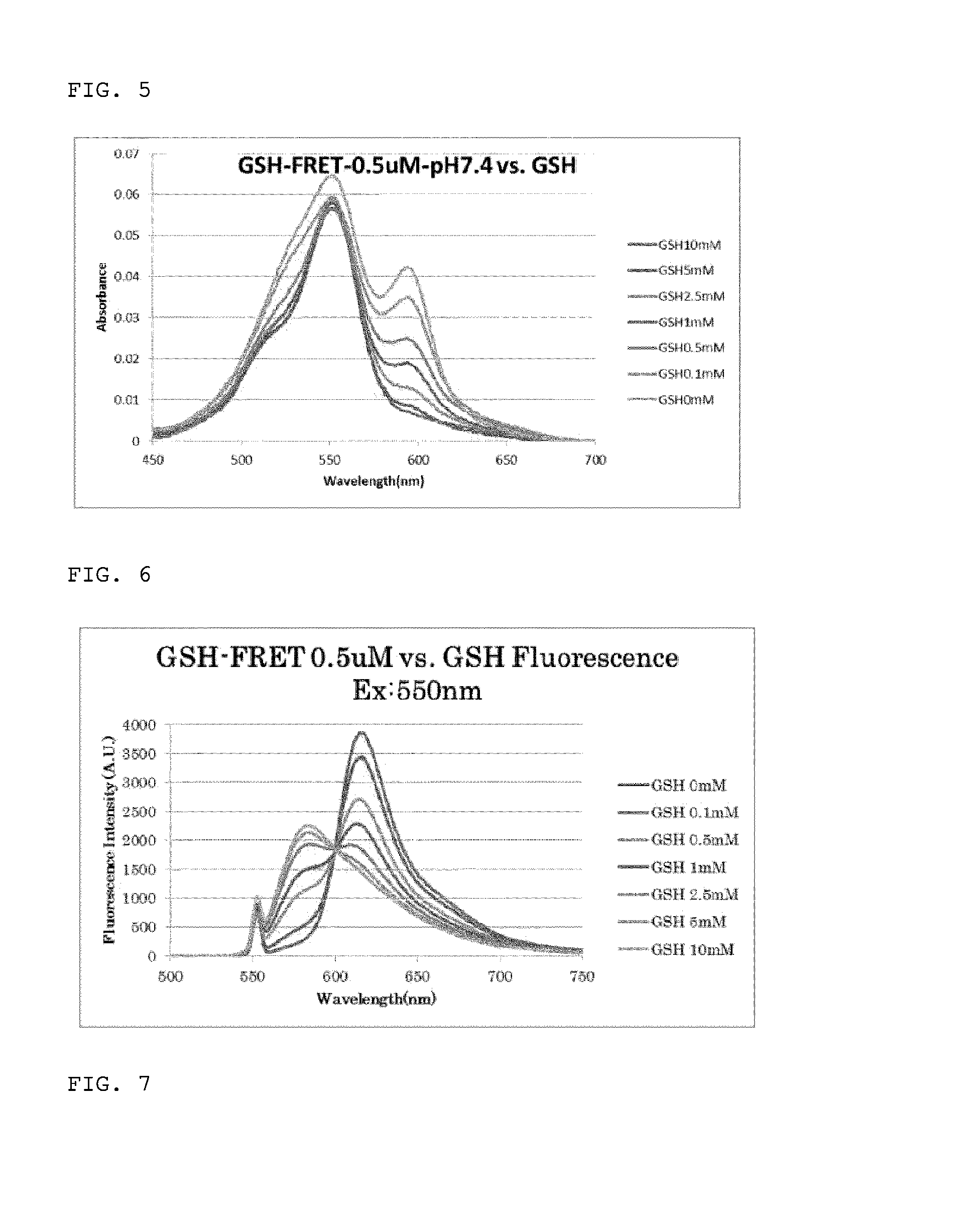Glutathione-detecting fluorescent probe
a fluorescent probe and glutathione technology, applied in the field of new glutathione detection fluorescent probes, fluorescent probes, can solve the problems of poor quantitativeness, oxidative stress exposure recovery, and inability to measure live cells, and achieve the effects of reducing glutathione, reducing oxidative stress, and great utility value and economic
- Summary
- Abstract
- Description
- Claims
- Application Information
AI Technical Summary
Benefits of technology
Problems solved by technology
Method used
Image
Examples
example 1
1. Synthesis of Fluorescent Probes
[0102]Synthesis of Compound 1 (2Me SiR600)
[0103]Compound 1 (2Me SiR600), which is a fluorescent probe of the present invention, was synthesized according to scheme 1 below. Furthermore, the synthesis of compound A2 is disclosed in Kushida K., et al., Bioorg. Med. Chem. Lett. 22(2012) 3908-3911, and synthesis was conducted based on that publication.
[0104]2-Bromotoluene (compound A1, 34.2 mg, 0.2 mmol, 6 Eq) was dissolved in THF (5 mL), and stirred for 10 minutes at −78° C. in an argon atmosphere. 1 M sec-butyllithium cyclohexane / n-hexane solution (0.2 mL, 0.2 mmol, 6 Eq) was added slowly, and stirred for 10 minutes. Compound A2 (14.5 mg, 0.034 mmol, 1 Eq) was added upon being dissolved in THF (3 mL), and stirred for one hour at −78° C. and for two hours at room temperature. The solution was acidified by adding 1N hydrochloric acid, and saturated sodium hydrogen carbonate aqueous solution was then added. The reaction system was extracted twice by dich...
example 2
Fluorescence Assay for Glutathione
[0311]Glutathione was reacted with the fluorescent probe 2Me SiR600 (compound 1) synthesized in Example 1, and fluorescence assay was conducted. A Shimadzu UV-2450 (Shimadzu Corporation) and a Hitachi F-7000 (Hitachi, Ltd.) were used in ultraviolet-visible spectroscopy and fluorescence spectroscopy. A fluorescent probe was diluted to a final concentration of 1 μM in 0.2 M sodium phosphate buffer (pH 7.4), containing 0.1-1% DMSO. The absorption spectrum and fluorescence spectrum were measured when various concentration of glutathione was added in the range of 1 μM-100 mM. The excitation wavelength was 590 nm. The results obtained are shown in FIGS. 1 and 2.
[0312]As shown in FIGS. 1 and 2, significant decreases in absorption and fluorescence intensity were found due to glutathione addition. By plotting values at absorption peak wavelength (593 nm) and fluorescence peak wavelength (614 nm) against glutathione concentration, the dissociation constant Kd...
example 3
Evaluation of Reversibility of Fluorescence Response
[0316]The reversibility of the reaction of the fluorescent probe and glutathione was evaluated by observing the change in absorption when glutathione was added, followed by addition of a thiol scavenger. Measurement was conducted using fluorescent probes of compound 1 “2Me SiR600” and compound 2 “Ph SiR650.” The results are shown in FIG. 3.
[0317]Based on the results in FIG. 3, these fluorescent probes were demonstrated to respond rapidly to glutathione (time until reaching equilibrium: 10 seconds or less) and to produce changes in absorption spectrum intensity depending on the glutathione level. The reversibility of the response to glutathione was confirmed by the fact that the absorbance returned to the same value without addition of glutathione when the thiol scavenger N-ethylmaleimide (NEM) was added.
PUM
 Login to View More
Login to View More Abstract
Description
Claims
Application Information
 Login to View More
Login to View More - R&D
- Intellectual Property
- Life Sciences
- Materials
- Tech Scout
- Unparalleled Data Quality
- Higher Quality Content
- 60% Fewer Hallucinations
Browse by: Latest US Patents, China's latest patents, Technical Efficacy Thesaurus, Application Domain, Technology Topic, Popular Technical Reports.
© 2025 PatSnap. All rights reserved.Legal|Privacy policy|Modern Slavery Act Transparency Statement|Sitemap|About US| Contact US: help@patsnap.com



